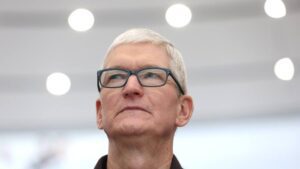
Gordon Moore, one of the founders of US chipmaker Intel and a central figure in the history of Silicon Valley, has died at the age of 94.
Moore’s early insight that the cost of electronics would plunge, turning digital technology into a part of everyday life, made his name a byword for the rapid and seemingly inexorable advance of the semiconductor sector, and with it the wider tech industry.
As one of three executives who shaped and led the chipmaker over its first three decades, he was a key figure in a company that is often said to have “put the silicon into Silicon Valley”, and helped to forge a style of entrepreneurial management that did much to shape the culture of the modern US tech industry.
In 1965, six years after the invention of the transistor, Moore forecast in a magazine article that the number of transistors and other components on a chip would double every year for the next decade. The prediction, dubbed Moore’s Law by an Intel colleague, has come to exemplify the onrush of technological advance ever since.
“I wanted to predict that this would be the way to make electronics inexpensively, which was not generally acknowledged at that time,” he later said. His prediction suggested that the number of transistors on a chip would leap from 60 to 60,000 over the next 10 years — “a pretty wild extrapolation” but one that turned out to be “ridiculously accurate”, he said.
He and others at Intel described Moore’s Law as a powerful motivating force, as much as an observation about the exponential advances that were likely to come from miniaturisation in electronics.
It was credited with helping to drive the company’s engineers to maintain a relentless pace of manufacturing process improvement that made Intel the global leader in chip making for decades, until it recently lost ground to TSMC and Samsung.
Born in San Francisco in 1929, Moore earned a PhD in chemistry at the California Institute of Technology before moving to the East Coast for a position at Johns Hopkins University. Within two years he was back in California after being hired by William Shockley, one of three people who were later awarded the Nobel Prize for the invention of the transistor.
Shockley’s overbearing management style soon alienated the group of brilliant young engineers he had assembled. In 1957, Moore was part of a group that quit to form a new business, Fairchild Semiconductor, as a division of a larger company.
Known as the Traitorous Eight, their defection made them exemplars of a new generation of young company founders with the ambition and drive to found an industry focused on electronics. Moore and Robert Noyce, another co-founder, later chafed at being forced to follow instructions from headquarters and in 1968 quit to set up their own company, Intel.
The unassuming Moore struck a less forceful figure than the other executives who shaped the chipmaker’s first decades.
His charismatic co-founder Noyce served as chief executive as Intel made its mark as a memory chip producer. Andy Grove, an early hire who later ran the company, was renowned for a hard-driving style that proved an asset when Intel was forced to abandon the memory chip market in the face of an onslaught of competition from Japan and reposition itself as a maker of computer processors.
Moore himself adopted a gentler style, though he played a key role in Intel’s management for years, first as an executive vice-president and president before serving as CEO from 1979 to 1987. He continued as chair for another decade and then as chair emeritus until 2006.
Moore spent his later years — along with a good part of his Intel fortune — on philanthropy, after founding the Gordon and Betty Moore Foundation with his wife. The organisation has donated $5.1bn since its founding in 2000 and backs causes including scientific discovery, environmental conservation, advances in patient care and preservation in the San Francisco Bay Area.
Moore modified his famous prediction in 1975 to forecast a doubling of transistor counts only every two years. The increasingly difficult challenge of producing chips with ever-smaller feature sizes has also led to frequent predictions of the “death of Moore’s law”.
Moore himself said he thought that point would have been reached long before miniaturisation reached its current stage, with the features on today’s most advanced chips only a few atoms wide.
But even as Intel and the rest of the industry face daunting challenges, the compound advances from the chip industry’s first half century have had a profound impact. One of Intel’s latest chips has more than 100bn transistors, around 43mn times as many as the company’s first processor, developed in 1971.
Moore is survived by his wife, Betty, his sons Kenneth and Steven, and four grandchildren.

